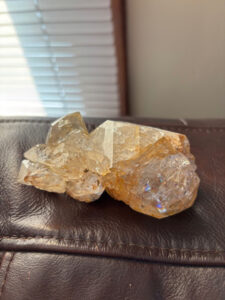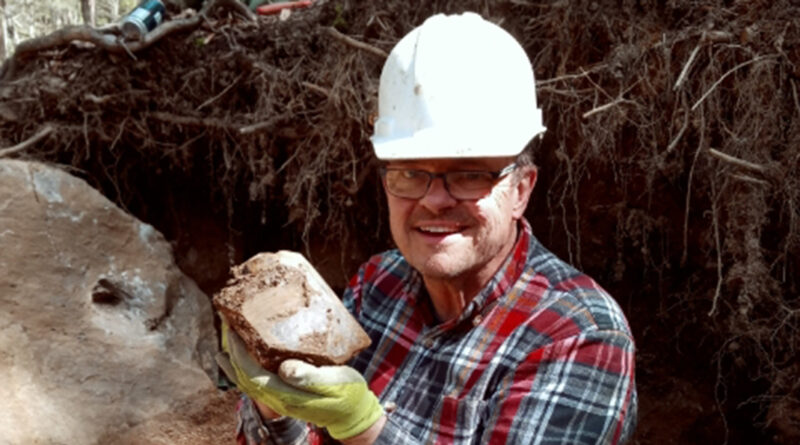For Funeral Director, It’s All About Gems, Minerals, Fossils
Matthew Klinger’s passion to find and collect gems led him to become the president of Gem and Mineral Society of Syracuse
By Stefan Yablonski

In his younger days, Matthew Klinger used to mine “diamonds” in Herkimer and later sell them.
Now 67, he is the president of the Gem and Mineral Society of Syracuse. He has been involved with the organization for 11 years.
“When I was a little kid, I’d pick rocks up and look at them. I’d take them home — and my father would take them out the back door and throw them in the garden,” he laughed.
He said his interest in gems and crystals really started when he was taking courses at Herkimer County Community College.
“It you get into it a bit deeper you can find some really cool stuff around here,” he said. “One of my other passions is Indian artifacts. I’ve got five or six plates of arrowheads and little pieces of other things. The oldest thing that I have is around 12,000 years old. It looks similar to an arrowhead, but it was actually a drill bit.”
Klinger said he bounced back and forth between Corning and Elmira.
“My dad was employed by New York State Electric and Gas — and every time he got a promotion, it was to where we weren’t living at the time. So we had to move,” he said.
He went to Herkimer Community College and studied mortuary science.
“I don’t know if they still have that. That was back in the ‘70s,” said Klinger, currently a funeral director at Goddard-Crandall-Shepardson Funeral Hone on James Street in Syracuse.
Society’s roots
Eight people organized the Gem and Mineral Society of Syracuse in 1951. Since then it has grown in membership to include “adults, families and young folk.” Members of the society range in age up to their 90s.
It joined Eastern Federation of Mineralogical and Lapidary Societies, Inc. in 1952.
The society was incorporated in 1969 under the same name.
The objectives of the society are to stimulate interest in mineralogy, paleontology and the lapidary arts. Member interests include collecting, identification and display of minerals, gems, fossils.
Members share and develop their artistic skills in jewelry design and creation.
Klinger and his team (were) organizing what he calls the “largest private show of gems and crystals” — the 58th Gem, Mineral, Fossil & Jewelry Show, held July 11-13 at the New York State Fairgrounds, he said.
The first day wasn’t for the public.
“We show up, set our stuff set up and get the vendors in so that they can get their stuff set up,” he said. “And then Saturday we opened for the public.”
They decided not to feature just one thing any more, “being around for as long as we have been around we have pretty much done it all,” he said.
They started planning a couple months ago.
“There’s a lot of pre-planning; stuff that our club sells has to be prepared,” he said. “We have a children’s section there with a sluice and the children will come in and buy a bag of dirt and put it through and there will be little gems and minerals in there. We have to make each of those bags. We make about 350 of those bags.
“We will usually have 40 or 50 people there on the night we do this. We have a straw draw. We take and cut straws in to little links and then we roll up a little piece of paper in there. You buy them for like a quarter or something and you pull the paper out to see what you’ve won. The kids love that and a lot of adults will stand there and pull those things all night, too. We have vendors from all over the place. There’s one guy from Brazil. He has some incredible stuff.”
Downsizing collection
“I have whittled my own collection down pretty good. But I still have a number of things,” he said. “My favorite part is finding them — and once I find them, I give a lot of them away. I drove my youngest son nuts. I’d give away a lot of stuff to little kids who didn’t find anything. I’d give them a handful of what I found.
“I go up Herkimer diamonds because it is close by and it is not that expensive. Generally, I don’t have a lot of time to do it. So being close by increases the amount of time I have to do it.”
He went from a four-bedroom home with an attached garage to a two-bedroom apartment, he explained.
“I’m turning my coin collection over to my nephews. I am at a point where if I want to fill the holes in my collection that I have to buy things and that’s not as fun,” he said.
Herkimer Diamonds: Are They Real Diamonds?
 Despite their name, Herkimer diamonds are not actually diamonds. Instead, they are a rare form of double-terminated quartz crystal that formed more than 500 million years ago in the dolomite rock of Herkimer County.
Despite their name, Herkimer diamonds are not actually diamonds. Instead, they are a rare form of double-terminated quartz crystal that formed more than 500 million years ago in the dolomite rock of Herkimer County.
Their name comes from their exceptional clarity and natural faceting, which give them a diamond-like brilliance.
Discovered in the 18th century, these gemstones are prized for their unique structure. Unlike most quartz, which grows with a single termination, Herkimers naturally form with two pointed ends and an average of 18 facets — without any need for cutting or polishing.

